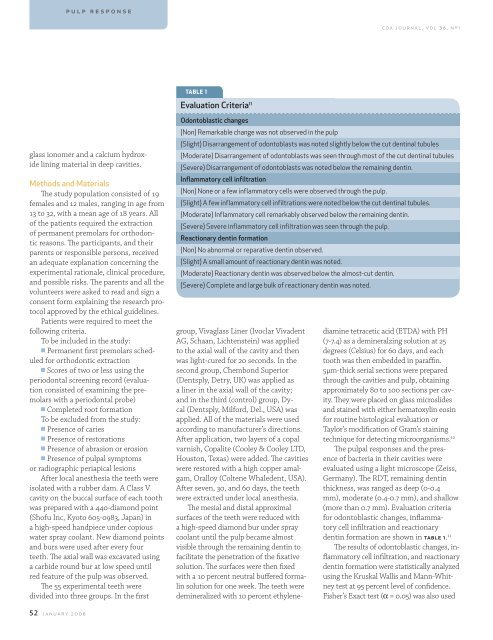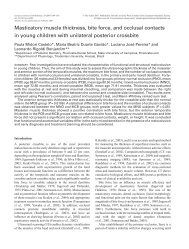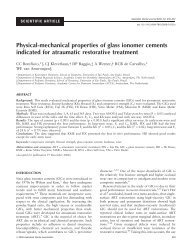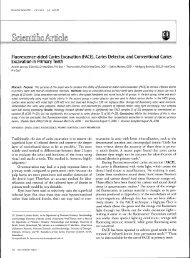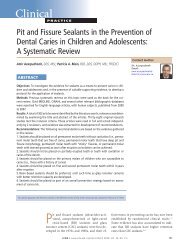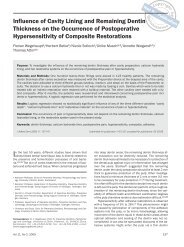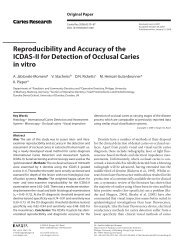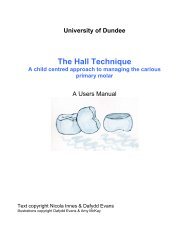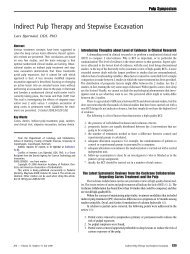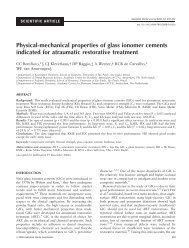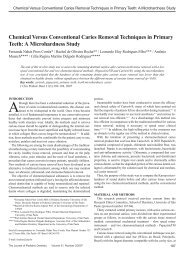January 2008 CDA Journal - Sandra Kalil Bussadori
January 2008 CDA Journal - Sandra Kalil Bussadori
January 2008 CDA Journal - Sandra Kalil Bussadori
You also want an ePaper? Increase the reach of your titles
YUMPU automatically turns print PDFs into web optimized ePapers that Google loves.
pulp response<br />
cda journal, vol 36, nº 1<br />
table 1<br />
Evaluation Criteria 11<br />
glass ionomer and a calcium hydroxide<br />
lining material in deep cavities.<br />
Methods and Materials<br />
The study population consisted of 19<br />
females and 12 males, ranging in age from<br />
13 to 32, with a mean age of 18 years. All<br />
of the patients required the extraction<br />
of permanent premolars for orthodontic<br />
reasons. The participants, and their<br />
parents or responsible persons, received<br />
an adequate explanation concerning the<br />
experimental rationale, clinical procedure,<br />
and possible risks. The parents and all the<br />
volunteers were asked to read and sign a<br />
consent form explaining the research protocol<br />
approved by the ethical guidelines.<br />
Patients were required to meet the<br />
following criteria.<br />
To be included in the study:<br />
n Permanent first premolars scheduled<br />
for orthodontic extraction<br />
n Scores of two or less using the<br />
periodontal screening record (evaluation<br />
consisted of examining the premolars<br />
with a periodontal probe)<br />
n Completed root formation<br />
To be excluded from the study:<br />
n Presence of caries<br />
n Presence of restorations<br />
n Presence of abrasion or erosion<br />
n Presence of pulpal symptoms<br />
or radiographic periapical lesions<br />
After local anesthesia the teeth were<br />
isolated with a rubber dam. A Class V<br />
cavity on the buccal surface of each tooth<br />
was prepared with a 440-diamond point<br />
(Shofu Inc, Kyoto 605-0983, Japan) in<br />
a high-speed handpiece under copious<br />
water spray coolant. New diamond points<br />
and burs were used after every four<br />
teeth. The axial wall was excavated using<br />
a carbide round bur at low speed until<br />
red feature of the pulp was observed.<br />
The 55 experimental teeth were<br />
divided into three groups. In the first<br />
Odontoblastic changes<br />
(Non) Remarkable change was not observed in the pulp<br />
(Slight) Disarrangement of odontoblasts was noted slightly below the cut dentinal tubules<br />
(Moderate) Disarrangement of odontoblasts was seen through most of the cut dentinal tubules<br />
(Severe) Disarrangement of odontoblasts was noted below the remaining dentin.<br />
Inflammatory cell infiltration<br />
(Non) None or a few inflammatory cells were observed through the pulp.<br />
(Slight) A few inflammatory cell infiltrations were noted below the cut dentinal tubules.<br />
(Moderate) Inflammatory cell remarkably observed below the remaining dentin.<br />
(Severe) Severe inflammatory cell infiltration was seen through the pulp.<br />
Reactionary dentin formation<br />
(Non) No abnormal or reparative dentin observed.<br />
(Slight) A small amount of reactionary dentin was noted.<br />
(Moderate) Reactionary dentin was observed below the almost-cut dentin.<br />
(Severe) Complete and large bulk of reactionary dentin was noted.<br />
group, Vivaglass Liner (Ivoclar Vivadent<br />
AG, Schaan, Lichtenstein) was applied<br />
to the axial wall of the cavity and then<br />
was light-cured for 20 seconds. In the<br />
second group, Chembond Superior<br />
(Dentsply, Detry, UK) was applied as<br />
a liner in the axial wall of the cavity;<br />
and in the third (control) group, Dycal<br />
(Dentsply, Milford, Del., USA) was<br />
applied. All of the materials were used<br />
according to manufacturer’s directions.<br />
After application, two layers of a copal<br />
varnish, Copalite (Cooley & Cooley LTD,<br />
Houston, Texas) were added. The cavities<br />
were restored with a high copper amalgam,<br />
Oralloy (Coltene Whaledent, USA).<br />
After seven, 30, and 60 days, the teeth<br />
were extracted under local anesthesia.<br />
The mesial and distal approximal<br />
surfaces of the teeth were reduced with<br />
a high-speed diamond bur under spray<br />
coolant until the pulp became almost<br />
visible through the remaining dentin to<br />
facilitate the penetration of the fixative<br />
solution. The surfaces were then fixed<br />
with a 10 percent neutral buffered formalin<br />
solution for one week. The teeth were<br />
demineralized with 10 percent ethylenediamine<br />
tetracetic acid (ETDA) with PH<br />
(7-7.4) as a demineralzing solution at 25<br />
degrees (Celsius) for 60 days, and each<br />
tooth was then embedded in paraffin.<br />
5µm-thick serial sections were prepared<br />
through the cavities and pulp, obtaining<br />
approximately 80 to 100 sections per cavity.<br />
They were placed on glass microslides<br />
and stained with either hematoxylin eosin<br />
for routine histological evaluation or<br />
Taylor’s modification of Gram’s staining<br />
technique for detecting microorganisms. 10<br />
The pulpal responses and the presence<br />
of bacteria in their cavities were<br />
evaluated using a light microscope (Zeiss,<br />
Germany). The RDT, remaining dentin<br />
thickness, was ranged as deep (0-0.4<br />
mm), moderate (0.4-0.7 mm), and shallow<br />
(more than 0.7 mm). Evaluation criteria<br />
for odontoblastic changes, inflammatory<br />
cell infiltration and reactionary<br />
dentin formation are shown in table 1. 11<br />
The results of odontoblastic changes, inflammatory<br />
cell infiltration, and reactionary<br />
dentin formation were statistically analyzed<br />
using the Kruskal Wallis and Mann-Whitney<br />
test at 95 percent level of confidence.<br />
Fisher’s Exact test (α = 0.05) was also used<br />
52 january <strong>2008</strong>


